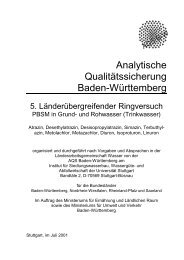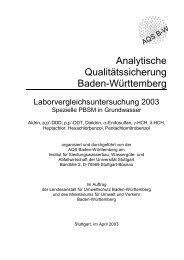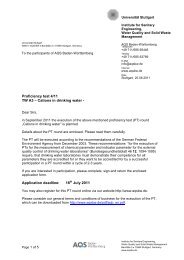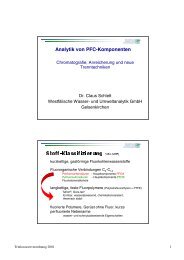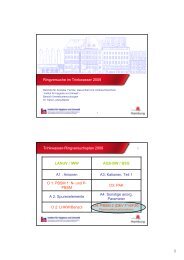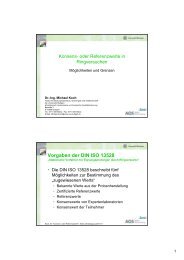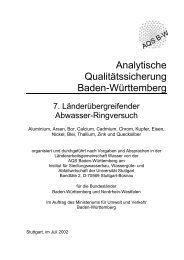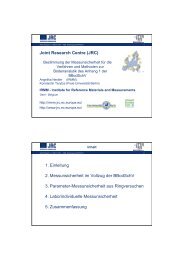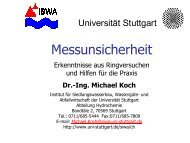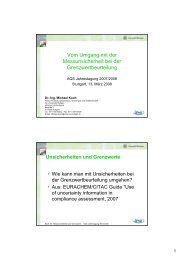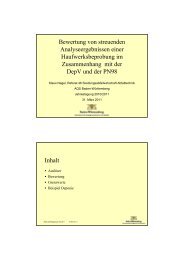Institute for Sanitary Engineering, Water Quality and Solid Waste ...
Institute for Sanitary Engineering, Water Quality and Solid Waste ...
Institute for Sanitary Engineering, Water Quality and Solid Waste ...
You also want an ePaper? Increase the reach of your titles
YUMPU automatically turns print PDFs into web optimized ePapers that Google loves.
Biological Air Purification ALR<br />
pH increased to alkaline conditions; optimal pH was<br />
found ranging between 7 – 7.5. The reduction process<br />
was improved by adding high amounts of citrate to<br />
the medium; the reduction percentage obtained was:<br />
55% of 1000 mg/L Cr(VI) using 4 g/L citrate <strong>and</strong> 76%<br />
of 1000 mg/L Cr(VI) using 6 g/L citrate. The biological<br />
reduction was inhibited in the presence of ions as Pb 2+ ,<br />
Zn 2+ , F - , Cu 2+ <strong>and</strong> Cl - in industrial wastewater containing<br />
Cr(VI). In addition, CRM100 was able to grow under<br />
anaerobic conditions within a variety of electron<br />
2- 2- 2-<br />
acceptors, including MoO 4<br />
, ClO 4-<br />
, AsO 4<br />
, SO 4<br />
<strong>and</strong><br />
-<br />
MnO 4<br />
as well. The results suggested the potential applicability<br />
of CRM100 <strong>for</strong> the bioremediation of metal<br />
contaminated wastewater<br />
Name: Diego Salamanca (WAREM) 2009<br />
Supervisor: Dr. N. Strunk<br />
Master Thesis<br />
an efficient system. Within an air flow the evaporated<br />
water as well as volatile organic compounds as well as<br />
anorganic compounds like H 2<br />
S <strong>and</strong> NH 3<br />
are separated<br />
from the dried matter. Poorly, high fluctuation in the<br />
composition of this air stream occure. A treatment of<br />
this high odorant air containing high carbon freights is<br />
necessary. Up to now state of the art techniques are<br />
not adequate to fulfil the limit values of 20 mg C/m³<br />
<strong>and</strong> 500 OU/m³ defined by the TA-Luft, respectively.<br />
The main task of this thesis was to choose adequate<br />
procedures <strong>for</strong> efficient treatment of this contaminated<br />
air <strong>and</strong> to verify <strong>and</strong> compare the efficiency of the<br />
choosen techniques in treating a real waste air flow of<br />
a cement plant. The focus lied on an evaluation of the<br />
procedures, feasibility of specific optimisation potential<br />
<strong>and</strong> selective treatment of a single <strong>and</strong> mixed waste<br />
air streams occurring on-site.<br />
Christian Wilde (Umweltschutztechnik) 2009<br />
Advisor: Dr.-Ing. D. Dobslaw<br />
Diploma Thesis<br />
Impact factors on the growth <strong>and</strong> degradation<br />
efficiency of nitrifying bacteria in a MBR-system<br />
in dairy industry<br />
Liquid culture of the strain CRM100. Right side: Fresh<br />
2-<br />
medium with 100 mg/L CrO 4<br />
. Left side: The cromate<br />
was reduced to green Cr(III)-compounds.<br />
Efficiency comparation of biological <strong>and</strong> non biological<br />
waste air treatment procedures <strong>for</strong> economical<br />
<strong>and</strong> ecological optimised treatment of<br />
belt dryer emissions in the cement industry<br />
Within endothermic clincer brick production processes<br />
out of lime in the cement industry high amounts of<br />
fossile fuels were necessary. Modern processes base<br />
on a thermal use of cadaver, animal meal, tyres, municipal<br />
<strong>and</strong> industrial sewage sludges instead of fossile<br />
fuels. About 5 % of the total energy dem<strong>and</strong> is covered<br />
by the thermal use of sewage sludges, which are<br />
not directly combustible in the rotary furnaces, because<br />
of their high water contents. A thermal pre-drying<br />
procedure using waste heat of the rotary furnace is<br />
During the production process of milk sugar powder<br />
using vacuum distillation procedures waste water<br />
streams with COD contents of up to 200 mg O2/L <strong>and</strong><br />
total nitrogen contents of up to 100 mg N/L are generated.<br />
These waste water flows are treated by a MBR<br />
system <strong>and</strong> the separation of treated water from the<br />
biomass in done by a ultra filtration step. The filtrate<br />
is further treated by a reverse osmosis unit <strong>for</strong> desalination<br />
<strong>and</strong> the permeat is fed into the process water<br />
circle. Precondition of the use as process water is an<br />
efficient nitrogen elimination by oxidation of the ammonia<br />
to nitrate <strong>and</strong> further denitrification to gaseous<br />
nitrogen. However, no efficient nitrification occurred in<br />
this system. The goal of this diploma theses was to<br />
find out which waste water vapours <strong>and</strong> permeates as<br />
well as process steps posses a high inhibitory potential.<br />
The focus lied on the behaviour of organic acids, especially<br />
lactic acid, shear <strong>for</strong>ces caused by the circulation<br />
pumps as well as the ejector system <strong>and</strong> turbulences<br />
in pH value <strong>and</strong> temperature in correlation to the ammonia<br />
oxidation rates appearing simultaneously.<br />
Tamara Linda Junghans (Umweltschutztechnik) 2009<br />
Advisor: Dr.-Ing. D. Dobslaw<br />
Diploma Thesis<br />
113




